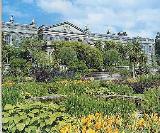| |
|
|
Throughout Ireland's
long  and torturous
history various forces have battled for the hearts and minds of
its people, but more importantly, ownership of the land with the
power and wealth it conferred on those controlling it. This was
the prime motivation, and the cause of the vast majority of wars
and battles in which countless thousands died, the vast majority
of these anonymous people who, had they lived, would not have been
any better off, nor would they have owned the land their spilt blood
was to nurture. They were merely expendable pawns in the power struggles
of the ruling elite. and torturous
history various forces have battled for the hearts and minds of
its people, but more importantly, ownership of the land with the
power and wealth it conferred on those controlling it. This was
the prime motivation, and the cause of the vast majority of wars
and battles in which countless thousands died, the vast majority
of these anonymous people who, had they lived, would not have been
any better off, nor would they have owned the land their spilt blood
was to nurture. They were merely expendable pawns in the power struggles
of the ruling elite.
The Norman invasion of the late 1100's lost
vast tracts of land to the native Irish, these lands they divided
among their leaders. The nature of man is such, that when he has
nothing he understandably wants something. But when he has enough
he always wants more, and the more he aquires the more he wants.
The Norman lords began to squabble between themselves, and attack
their Irish neighbours, in areas as yet unconquered.
While at one time holding sway over a considerable
part of the country, they never gained absolute control, principally
because Ireland, unlike England lacked a central administration
center. Ireland was ruled by many minor kings who owed allegiance
to a high king or 'Ard Ri' The last high king is generally accepted
to have been Rory O'Connor who died in 1198, and was buried in Clonmacnoise
County Offaly.
In the two centuries beginning in 1500 ownership of the vast majority
of Irish land fell into the hands of English landlords
This tragedy of human greed, has been played
through endless generations, from the earliest history to the farce
that is Stormont today. The outward symbols of this endless suppression
of the people have survived in the churches, castles, grand stately
homes and latterly government buildings. These are a testament to
the wealth of a country and its people subverted to the glory of
an individual or family by the ruling class or church. The wonder
in the stained glass, that tells of our place in Gods design, that
we dare not question, pillars that soar to heaven vaulted in wood
or stone, reinforces our inferiority to the church and its dogma.
|
When visiting, these often wonderful places, it
is easy to be seduced by the art and beauty of their architecture, their
paintings and antiques, their estates set out in parklands that resemble
paintings, a stage-set of an idealized nature, confined and controlled
by these Patricians fathers.
We forget the human cost of these treasures, as
we marvel at their marble halls, their stained glass, what we should marvel
at is the skill of the craftsmen who produced them, we forget the drudgery
of the humble housemaids,
slaving to light their fires and wash their clothes. The countless
gardeners, up at dawn manicuring the garden sparing their masters eyes
the specticle of their lowly forms, struggling against the odds to grow
exotic fruit and flowers, to grace their dinner tables. The families condemned
to subsist on a diet of potatoes in an earthed floor hovel, on the edges
of these often-vast estates, to be evicted because sheep are more profitable
or their humble dwellings
spoil the view from the dinning room.
As we wonder, we forget, that the Dutch
East India Company, that furnished so many of these grand houses with
their silks and satins; the magnificent Italian bronzes and marble friezes,
acquired on the 'Grand Tour', that made self perceived 'Gentlemen' out
of 'carpet baggers' . We turn an eye, beguiled by the beauty of these
rare and privileged lives, oblivious to the fact, that what we should
see displayed on these walls, are, the blood sweat and deaths of an infinite
number of African slaves, condemned to die on the plantations of the Caribbean,
producing the sugar or cotton that paid for such wealth. Or the endless
supply of young Irish soldiers ( the poor boys everywhere ) recruited
into a British army, to fight foreign wars, for private profit, or to
perpetuate the rule fighting cousins on their thrones, which was the blood
bath that began the first World War.
|
|

 and torturous
history various forces have battled for the hearts and minds of
its people, but more importantly, ownership of the land with the
power and wealth it conferred on those controlling it. This was
the prime motivation, and the cause of the vast majority of wars
and battles in which countless thousands died, the vast majority
of these anonymous people who, had they lived, would not have been
any better off, nor would they have owned the land their spilt blood
was to nurture. They were merely expendable pawns in the power struggles
of the ruling elite.
and torturous
history various forces have battled for the hearts and minds of
its people, but more importantly, ownership of the land with the
power and wealth it conferred on those controlling it. This was
the prime motivation, and the cause of the vast majority of wars
and battles in which countless thousands died, the vast majority
of these anonymous people who, had they lived, would not have been
any better off, nor would they have owned the land their spilt blood
was to nurture. They were merely expendable pawns in the power struggles
of the ruling elite.